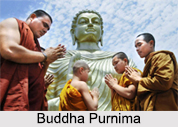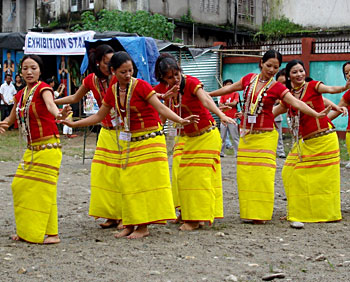 Pandharpur is a town in district Solapur in state of Maharashtra in Western India. Temple of Vithoba at Pandharpur, on the bank of Bhima is an important shrine particularly for the Maharashtrians. This temple, covering a vast area, has a total of six gates. The eastern entrance to this temple is known as the Namdev gate. The sanctum enshrines a standing image of Vithoba also known as Panduranga, Pandhari, Vitthala or Vithoba. The worship of Vishnu - Vithoba at Pandharpur is derived mainly from the puranas and has been augmented by the contribution of the great Vaishnava saints of Maharashtra and Karnataka from the 13th through the 17th centuries like Dnyaneshwar, Namdev, Sant Eknath, Tukaram and many others. Three feasts are annually held in April, July and November. Vithoba is revered as the form of Vishnu or of Krishna, his eighth incarnation.
Pandharpur is a town in district Solapur in state of Maharashtra in Western India. Temple of Vithoba at Pandharpur, on the bank of Bhima is an important shrine particularly for the Maharashtrians. This temple, covering a vast area, has a total of six gates. The eastern entrance to this temple is known as the Namdev gate. The sanctum enshrines a standing image of Vithoba also known as Panduranga, Pandhari, Vitthala or Vithoba. The worship of Vishnu - Vithoba at Pandharpur is derived mainly from the puranas and has been augmented by the contribution of the great Vaishnava saints of Maharashtra and Karnataka from the 13th through the 17th centuries like Dnyaneshwar, Namdev, Sant Eknath, Tukaram and many others. Three feasts are annually held in April, July and November. Vithoba is revered as the form of Vishnu or of Krishna, his eighth incarnation.
There are various legends explaining the origin of Vithoba, but all agree that this manifestation of the god was occasioned by the filial goodness of a Brahmin named Pundalik. Pundalik`s fame for filial devotion reached Vishnu (in the incarnation of Krishna) and this god paid a visit to Pundalik in his house at Pandharpur. When the visitor came, Pundalik was serving his parents and the latter getting enraged at the interruption heaved a brick at him. However, in another version of the legend, it is related that the saint only threw a brick for the god to rest on, as he was too busy with his filial duties to find a better seat.
 Anyway, the god was highly pleased with the devotion of Pundalik to his parents and remained in Pandharpur. Thus, his image stands on a brick, and devotees of Vithoba often identify themselves as the brick under the god`s feet, denoting complete self-surrender, a distinctive feature of the devotional Bhakti cult. The word "Vitthala" is said to be derived from the Marathi/Kannada word "Vittu", meaning, "brick".
Anyway, the god was highly pleased with the devotion of Pundalik to his parents and remained in Pandharpur. Thus, his image stands on a brick, and devotees of Vithoba often identify themselves as the brick under the god`s feet, denoting complete self-surrender, a distinctive feature of the devotional Bhakti cult. The word "Vitthala" is said to be derived from the Marathi/Kannada word "Vittu", meaning, "brick".
Narayan Baba, the youngest son of Tukaram started the Pandharpur Festival in 1685, since he wanted to bring about a change in the mode of celebration. So, he introduced the Palkhi, which is a sign of social respect. The Pandharpur festival focuses on several other shades, which only a true warkari can comprehend. Warkari people are those, who follow the wari (a holy ritual). Thus, this religious festival is carried out on a very large scale, where a Palkhi (palanquin) is a unique feature of this festival.
A Palkhi is a thousand-year-old tradition followed by the warkaris and a unique feature of Maharashtrian culture. The Palkhi starts in the month of Jyeshtha of the Hindu calendar. The palanquins contain the padukas and masks of the saints,
 Dnyaneshwar and Tukaram. The procession and the religious celebrations last for almost three weeks. Nearly sixty palanquins from all over Maharashtra are taken to Pandharpur. The palkhi of Dnyaneshvar sets out from Alandi while that of Tukaram from Dehu, of Nivrittinath from Tryambakeshwar, and of Ekanath from Paithan. And every year on the 11th day of the first half of the Hindu month of Ashadh, the Palkhi reaches Pandharpur. The whole area of Vithoba Temple is full of Warkaris, of all ages and and the atmosphere is full of the cheers that have echoes of `Jai Jai Vithoba-Rakhumait, Jai Jai Vithoba Rakhumai!`
Dnyaneshwar and Tukaram. The procession and the religious celebrations last for almost three weeks. Nearly sixty palanquins from all over Maharashtra are taken to Pandharpur. The palkhi of Dnyaneshvar sets out from Alandi while that of Tukaram from Dehu, of Nivrittinath from Tryambakeshwar, and of Ekanath from Paithan. And every year on the 11th day of the first half of the Hindu month of Ashadh, the Palkhi reaches Pandharpur. The whole area of Vithoba Temple is full of Warkaris, of all ages and and the atmosphere is full of the cheers that have echoes of `Jai Jai Vithoba-Rakhumait, Jai Jai Vithoba Rakhumai!`
The warkaris chant `Dnyanba Tukaram` (meaning: Dnyaneshwar and Tukaram), while they trek their way to Pandharpur on foot, in the company of the palanquins of the various saints. Such a procession to the holy town of Pandharpur in Hindu months of Ashadh (June-July) and Karthik (November-December) is called Dindi (Bhajan party).



















